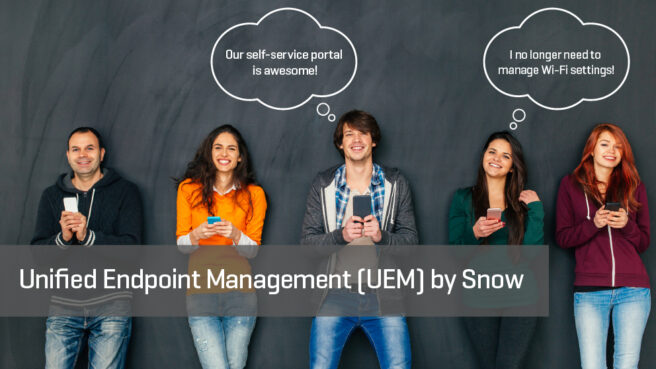Unified Endpoint Management (UEM) by Snow

As I discussed in a previous post Unified Endpoint Management (UEM) – it starts with the user, most UEM solutions are designed from a security-first perspective. Our approach to UEM is holistic, designed to bring the business units of an organization closer together, and built with security in mind, but also taking ease-of-use, productivity, security, and cost management into consideration.
UEM by Snow starts with knowing your unknowns. The discovery and inventory data that details the endpoints connected to the corporate network and how and what software and applications they consume is the foundation – single source of truth – of UEM.
Knowing your endpoints and their consumption is the first step toward understanding what and how your organization is consuming technology assets. It is the intelligence that enables your organization to make data-driven decisions to design security, IT spend management, service-delivery, and automation processes that fit your business best.
Using this intelligence as the foundation, UEM by Snow provides layered functionality to manage the mobile park, workflow automation, license compliance, and cost control.
Snow inventory
Discovery and inventory lie at the core of Snow’s technology, providing the insight about the technology endpoints – such as desktops, servers, virtual machines, mobiles, laptops, and network switches –connected to the corporate network, the applications installed on them, how that software is consumed, by whom, and when. Running daily, discovery and inventory reveal blind spots – endpoints connecting to the network but not reporting data – and create a history of endpoint activity including usage statistics of software consumption from the information extracted by agents and agentless technology.
You can find out more about Snow’s core technology in Removing your IT blind spots.
Snow Device Manager
To support a mobile workforce, specialized functionality is needed to manage and protect devices like smartphones and tablets as they roam beyond the security of the corporate network. Functionality like remote wipe, separation of corporate and private data, encryption, zero-touch delivery, app stores, and integration with manufacturer programs developed by device manufacturers are specific to mobile endpoints. Snow’s device management technology has been designed on the principles of cost control and risk management, promoting self-service, seamless delivery of security measures without interfering with user productivity, and reduction of calls to the IT service desk.
You can find out more about Snow’s enterprise mobility management in the Ten top things you should know about Snow Device Manager.
Snow Automation Platform
The administrative and support tasks needed to manage endpoints, applications, and software throughout their life cycles tend to be systematic. Processes like onboarding new employees, requesting access to software, checking compliance, approving requests, re-harvesting licenses, and spinning up virtual machines often follow a set procedure and without automation tend to be time-consuming and error-prone.
Automating such repeatable tasks, which can sometimes be complex or require expertise, provides organizations with, for example, continuous regulatory and service compliance enforcement and improved business productivity.
At Snow, automation starts with enabling users to be productive. All types of business processes, such as requesting new devices, ordering additional software or apps, and procuring services can be automated, with approvals in-built, through a self-service portal.
You can find out more about Snow’s automation technology, and how it supports organizations in Creating a user-centric approach to Software Asset Management (SAM).
Snow License Manager
UEM by Snow comes together under Snow License Manager. This part of our solution provides the licensing intelligence, reporting, cost management, and visualization for full control over technology endpoints, such as virtual machines running high-end middleware solutions, or single devices running a kiosk app, or datacenters running business-critical applications. Snow License Manager provides the visualization for all endpoints, the applications installed them, who is consuming the applications and how much, compliance and coverage calculations, as well as financial control.
You can find out more about Snow License Manager and how it provides organizations with insight and visibility into usage so they can optimize their software estates, reduce licensing costs and successfully defend vendor audits.
MANAGING ALL ASPECTS OF THE TECHNOLOGY LIFE CYCLE
UEM by Snow manages all aspects of the endpoint life cycle with benefits for many roles within the business, such as:
- For the SAM manager – full visibility over endpoints, users, and software consumption, with capabilities for assuring compliance, automatic license re-harvesting, SaaS subscription optimization, and cost management.
- For the service desk – integrations with popular ITSM tools ensures the CMDB is populated with cleansed and normalized data. Automated processes ensure that low-level tasks related like supplying Wi-Fi settings and passwords are removed, and complex tasks like spinning up VMs can be automated to systematically uphold security measures.
- For the security officer – automation provides a systematic way of implementing security policies, and mobility management provides users with the right level of flexibility to ensure that security measures are not side-stepped.
- For the employee – seamless user experience with self-service for instant productivity and in-built security policies easing the burden of responsibility.
- For the organization – central management of all devices, operating systems, and software and services, bringing business units like finance, procurement, and IT closer together.
This is my final post in this series on Unified Endpoint Management. Previously, I’ve talked about UEM, by Snow, UEM – productivity for everyone, UEM – seven best practices, and UEM – it starts with the user. I hope you have enjoyed the series and that my insights from many years developing Snow Device Manager have been useful.